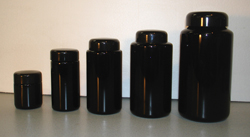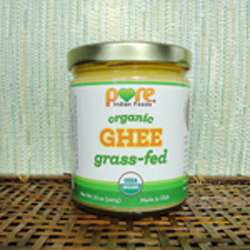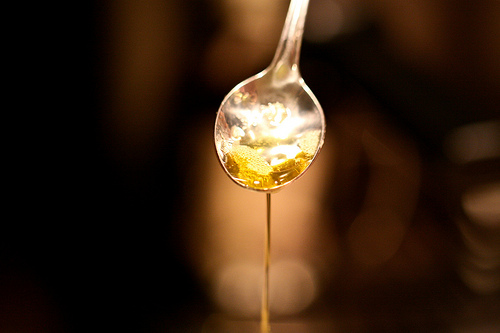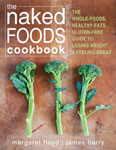Ghee is a misunderstood kitchen essential for every modern-day whole foods cook. A nutrient-dense culinary gem, it offers a unique, nutty flavor that is excellent for baking, high-temperature cooking and as a delightful spread. In this week's edition of Radiant Life's Recipe Tuesday, learn how to add a flair to your cooking by properly making and using grass fed ghee.
Image Courtesy of Susy Morris at Chiots Run
What in the World is Ghee?
To the western ear the term “ghee” can seem somewhat strange and unappealing. I strolled by jars of it in the health foods market countless times, discounting it as some complicated substance that I had no idea how to use and would likely botch in the kitchen. But in fact, ghee is perhaps one of the most misunderstood ingredients and is now a staple in our Radiant Life kitchen pantry.
Simply put, ghee is clarified butter. It is the pure golden-yellow butter oil that remains when the the milk solids and water have been removed. Ghee is an honored ancient food that has been used both in Indian cooking and as an Ayurvedic healing tonic to nourish and heal the body for thousands of years. This “Royal Oil” is traditionally attributed to stimulating one’s ojas, or “life energy” and continues to be carefully blended in many ayurvedic herbal tinctures to enhance therapeutic effects.
A Home Chef's Best Friend
In a culinary respect, ghee is most commonly incorporated into Indian cuisine, but the powerful benefits and joyful taste of ghee need not be exclusively cornered here. Butter oil is rich in fat soluble vitamins which aid in the absorption of nutrients in foods. It is phenomenal for general sautéing, roasting, baking, drizzling, and spreading. Because it lacks milk solids and is both lactose and casein-free, ghee is easily digestible especially for those with dairy intolerance. Furthermore, it lacks the ominously heavy “cheesy” odors that grass fed butter sometimes emits during the cooking, making it a favorable alternative for many. Ghee is also reliable in that it does not spoil easily, nor does it require refrigeration. Thus it deserves a “gold metal spot” in your pantry for trustworthy, quick use.
Do-It-Yourself Ghee
While some of us here at Radiant Life are purely butter enthusiasts, I personally tend to gravitate towards ghee. I always quip, "it's ghee for mee!" but don't take my word for it...try it yourself! Here is a quick recipe from The Naked Foods Cookbook that I use when feeling ambitious.
Makes 1 1/2 to 1 3/4 cups
2 cups organic, unsalted, grass fed butter
Put butter in a small saucepan over medium-low heat. Butter will melt and then simmer. It will start to bubble gently with a kind of popping sound. Make sure it doesn’t come to a full boil. You’ll notice that white milk solids will separate from the butter oil and eventually settle down to the bottom of the saucepan. This takes about 30 minutes. When all of the milk solids have settled to the bottom, the ghee is ready. If a few stubborn solids remain at the top- just skim these off gently.
 Using a fine strainer, pour the oil into a glass jar. Leave uncovered at room temperature to cool. Once cooled cover with lid and store it in cool, dark cupboard. Ghee will keep for several months and does not require refrigeration. I like to use VioLiv containers to preserve the integrity of the oil, dramatically extend shelf life and actually enhance quality with age.
Using a fine strainer, pour the oil into a glass jar. Leave uncovered at room temperature to cool. Once cooled cover with lid and store it in cool, dark cupboard. Ghee will keep for several months and does not require refrigeration. I like to use VioLiv containers to preserve the integrity of the oil, dramatically extend shelf life and actually enhance quality with age.
Trusted On-The-Go Convenience

Sometimes these steps can be overwhelming and time consuming when trying to prepare meals on the go. Also remember, not all ghee is created equal and the beautiful nutrient balance that makes it so exceptional can be easily destroyed in its creation. For a convenient, reliable alternative to “do-it-yourself ghee” try the Weston A. Price Foundation recommended Pure Grassfed Ghee. This particular ghee has undergone our scrutinous selection process and is derived from butter that is organic and made from the non-homogenized milk of grass fed cows.
For more ideas on how to incorporate this nutritional treasure into your diet, visit the recipe tab on our Pure Grassfed Ghee product page. Try it drizzled over steamed veggies, sautéed with garlic to make an out-of-this-world hummus,or stir into steaming soups just before serving for additional depth in flavor.
Check out other great ways to use ghee in our brand new Naked Foods Cookbook. It offers delectable collection of gluten-free recipes with witty commentary and fun tips. Some of my favorite ghee-sporting dishes are the Savory Stove Top Popcorn, Noodle-less Lasagna and White Bean Leek Soup.


